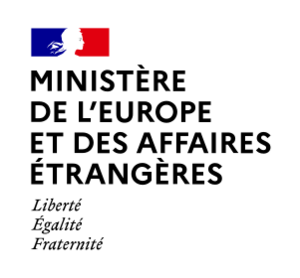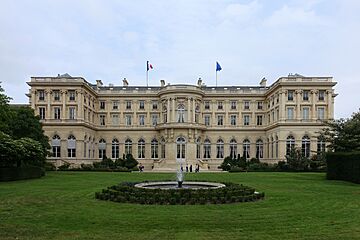Ministry for Europe and Foreign Affairs (France) facts for kids
 |
|
| Agency overview | |
|---|---|
| Formed | 1547 |
| Jurisdiction | Government of France |
| Headquarters | Hôtel du ministre des Affaires étrangères, 37 Quai d'Orsay, Paris 7e |
| Agency executive |
|
The Ministry for Europe and Foreign Affairs (which in French is Ministère de l'Europe et des Affaires étrangères, often shortened to MEAE) is a very important part of the Government of France. Its main job is to handle France's relationships with other countries around the world. This is called foreign relations.
Since 1855, the Ministry's main office has been at a famous address: 37 Quai d'Orsay in Paris. This building is very close to the National Assembly, which is where French laws are made. Because of its location, people often use the name Quai d'Orsay as a nickname for the Ministry itself.
The person in charge of this Ministry is called the Minister for Europe and Foreign Affairs. This Minister is responsible for how France talks and works with other nations. The current Minister, Stéphane Séjourné, started this important role in 2024. He works with other special ministers to help him. These include Chrysoula Zacharopoulou, who focuses on development and international partnerships, and Jean-Noël Barrot, who handles European affairs. There's also Franck Riester, who deals with foreign trade and French citizens living abroad.
Contents
How France Talks to Other Countries
France has been talking to other countries for a very long time. Back in 1547, French kings had special helpers called royal secretaries. Their job was to write letters to foreign governments and help make peace agreements.
Over time, this work became more organized. By 1589, one main secretary was in charge of all international relations. This role eventually became known as the Foreign Minister around 1723. During the French Revolution, in 1791, the name changed to Minister of Foreign Affairs.
For a short time in the 1980s, the Ministry was called the "Minister for External Relations." Today, it's known as the Ministry of Europe and Foreign Affairs.
What the Ministry Does
The Ministry for Europe and Foreign Affairs has many different teams and departments that help it do its job. These teams work together to manage France's relationships with countries all over the world. They also work with other French government departments when needed.
Some of the key teams and services within the Ministry include:
- The Minister's own team: This group helps the Minister with daily tasks and decisions.
- The budget control service: This team makes sure the Ministry's money is spent wisely.
- The general inspection of foreign affairs: This group checks that everything is running smoothly and correctly.
- The protocol office: This team handles all the formal rules and customs for official meetings and visits with foreign leaders. They make sure everything is done respectfully.
- The crisis management department: This important team helps France respond quickly to big problems or emergencies happening in other countries, especially if French citizens are involved.
Who Were the Ministers?
Many people have held the important job of leading France's foreign relations over the centuries. From the early royal secretaries to today's Minister, each person has played a part in shaping how France interacts with the rest of the world.
Here are some of the key periods and the names of the people who served in this role:
Early Secretaries of State (1547–1723)
This was when the role of managing foreign affairs first started to become a special job.
- Guillaume Bochetel (1547–1558)
- Côme Clausse (1547–1559)
- Claude de l’Aubespine (1547–1567)
- Jean du Thiers (1547–1559)
- Jacques Bourdin (1558–1567)
- Florimond II Robertet, seigneur de Fresnes (1558–1567)
- Florimond III Robertet d'Alluye (1559–1569)
- Simon Fizes, baron de Sauves (1567–1579)
- Nicolas de Neufville, seigneur de Villeroy (1567–1588)
- Pierre Brûlart, seigneur de Genlis (1569–1588)
- Claude Pinart (1570–1588)
- Louis de Revol (1589–1594)
- Nicolas de Neufville, seigneur de Villeroy (1594–1616)
- Armand Jean du Plessis, duc de Richelieu (1616–1617)
- Pierre Brulart (1617–1626)
- Raymond Phelypeaux, seigneur d'Herbault (1626–1629)
- Claude Bouthillier (1629–1632)
- Léon Bouthillier, comte de Chavigny (1632–1643)
- Henri-Auguste de Loménie, comte de Brienne (1643–1663)
- Hugues de Lionne (1663–1671)
- Simon Arnauld, marquis de Pomponne (1671–1679)
- Charles Colbert, marquis de Croissy (1680–1696)
- Jean-Baptiste Colbert, marquis de Torcy (1696–1715)
- Nicolas du Blé, marquis d'Huxelles (1715–1718)
Ministers of Foreign Affairs (1718–1791)
This period saw the role become more formally known as "Minister for Foreign Affairs."
- Guillaume Dubois (1718–1723)
- Charles Jean-Baptiste Fleuriau, comte de Morville (1723–1727)
- Germain Louis Chauvelin (1727–1737)
- Jean-Jacques Amelot de Chaillou (1737–1744)
- Adrien Maurice, duc de Noailles (1744)
- René de Voyer de Paulmy, marquis d'Argenson (1744–1747)
- Louis Philogène Brûlart, vicomte de Puisieulx (1747–1751)
- François Dominique de Barberie de Saint-Contest (1751–1754)
- Antoine Louis Rouillé (1754–1757)
- François Joachim de Pierre de Bernis (1757–1758)
- Étienne François, duc de Choiseul (1758–1761, 1766–1770)
- César Gabriel de Choiseul-Chevigny (1761–1766)
- Louis Phélypeaux, duc de La Vrillère (1770–1771)
- Emmanuel Armand de Vignerot du Plessis de Richelieu, duc d'Aiguillon (1771–1774)
- Henri Léonard Jean Baptiste Bertin (1774)
- Charles Gravier, comte de Vergennes (1774–1787)
- Armand Marc, comte de Montmorin Saint-Hérem (1787–1789, 1789–1791)
- Paul François de Quelen, duc de la Vauguyon (1789)
Ministers During the French Revolution and Empire (1791–1815)
This was a time of big changes in France, and the foreign affairs role also changed.
- Claude Antoine Valdec de Lessart (1791–1792)
- Charles Dumouriez (1792)
- Pierre Paul de Méredieu, baron de Naillac (1792)
- Scipion Victor, marquis de Chambonas (1792)
- François Joseph de Gratet, vicomte Dubouchage (1792)
- Claude Bigot de Sainte-Croix (1792)
- Pierre Henri Hélène Marie Lebrun-Tondu (1792–1793)
- François Louis Michel Chemin Deforgues (1793–1794)
- Jean Marie Claude Alexandre Goujon (1794)
- Martial Joseph Armand Herman (1794)
- Philibert Buchot (1794–1795)
- Michel Ange Bernard Mangourit (1794)
- André François Miot de Melito (1794–1795)
- Jean-Victor Colchen (1795)
- Charles-François Delacroix (1795–1797)
- Charles Maurice de Talleyrand-Périgord (1797–1799, 1799–1807, 1814–1815)
- Charles-Frédéric Reinhard (1799)
- Jean-Baptiste Nompère de Champagny (1807–1811)
- Hugues Bernard Maret (1811–1813)
- Armand Augustin Louis Caulaincourt (1813–1814, 1815)
- Antoine René Charles Mathurin, comte de Laforest (1814)
- Louis, baron Bignon (1815, 1830)
Ministers from 1815 to 1944
This long period includes different governments, like monarchies and republics.
- Armand Emmanuel du Plessis, duc de Richelieu (1815–1818)
- Jean Joseph Paul Augustin, marquis Dessolles (1818–1819)
- Étienne Denis, baron Pasquier (1819–1821)
- Mathieu Jean Félicité, duc de Montmorency-Laval (1821–1822)
- François-René, vicomte de Chateaubriand (1822–1824)
- Ange Hyacinthe Maxence, baron de Damas (1824–1828)
- Auguste, comte de La Ferronays (1828–1829)
- Anne Pierre Adrien, duc de Montmorency-Laval (1829)
- Joseph-Marie, comte Portalis (1829)
- Jules Armand Auguste Marie, prince de Polignac (1829–1830)
- Victor Louis Victurnien, duc de Mortemart (1830)
- Jean-Baptiste, comte Jourdan (1830)
- Louis, comte Molé (1830, 1836–1839)
- Nicolas Joseph, marquis Maison (1830)
- Horace François Bastien, baron Sébastiani (1830–1832)
- Victor, duc de Broglie (1832–1834, 1835–1836)
- Henri Gauthier, comte de Rigny (1834, 1834–1835)
- Charles Joseph, comte Bresson (1834)
- Adolphe Thiers (1836, 1840)
- Louis Napoléon Lannes (1839)
- Nicolas Jean de Dieu Soult (1839–1840)
- François Guizot (1840–1848)
- Alphonse de Lamartine (1848)
- Jules Bastide (1848, 1848)
- Marie-Alphonse Bedeau (1848)
- Édouard Drouyn de Lhuys (1848–1849, 1851, 1852–1855, 1862–1866)
- Alexis de Tocqueville (1849)
- Alphonse de Rayneval (1849)
- Jean-Ernest Ducos, vicomte de La Hitte (1849–1851)
- Anatole, baron Brénier de Renaudière (1851)
- Jules Baroche (1851, 1860)
- Louis Félix Étienne, marquis de Turgot (1851–1852)
- Alexandre Colonna, comte Walewski (1855–1860)
- Édouard Thouvenel (1860–1862)
- Charles, marquis de La Valette (1866, 1868–1869)
- Lionel de Moustier (1866–1868)
- Henri, prince de La Tour d'Auvergne (1869–1870, 1870)
- Napoléon, comte Daru (1870)
- Émile Ollivier (1870)
- Agenor, duc de Gramont (1870)
- Jules Favre (1870–1871)
- Charles, comte de Rémusat (1871–1873)
- Albert, duc de Broglie (1873)
- Louis Decazes (1873–1877)
- Gaston-Robert, marquis de Banneville (1877)
- William Henry Waddington (1877–1879)
- Charles de Freycinet (1879–1880, 1882, 1885–1886)
- Jules Barthélemy-Saint-Hilaire (1880–1881)
- Léon Gambetta (1881–1882)
- Charles Duclerc (1882–1883)
- Armand Fallières (1883)
- Paul-Armand Challemel-Lacour (1883)
- Jules Ferry (1883–1885)
- Émile Flourens (1886–1888)
- René Goblet (1888–1889)
- Eugène Spuller (1889–1890)
- Alexandre Ribot (1890–1893, 1917)
- Jules Develle (1893)
- Jean Casimir-Perier (1893–1894)
- Gabriel Hanotaux (1894–1895, 1896–1898)
- Marcellin Berthelot (1895–1896)
- Léon Bourgeois (1896, 1906, 1914)
- Théophile Delcassé (1898–1905, 1914–1915)
- Maurice Rouvier (1905–1906)
- Stéphen Pichon (1906–1911, 1913, 1917–1920)
- Jean Cruppi (1911)
- Justin de Selves (1911–1912)
- Raymond Poincaré (1912–1913, 1922–1924)
- Charles Jonnart (1913)
- Gaston Doumergue (1913–1914, 1914)
- René Viviani (1914, 1915)
- Aristide Briand (1915–1917, 1921–1922, 1925–1926, 1926–1932)
- Louis Barthou (1917, 1934)
- Alexandre Millerand (1920)
- Georges Leygues (1920–1921)
- Edmond Lefebvre du Prey (1924)
- Édouard Herriot (1924–1925, 1926, 1932)
- Pierre Laval (1932, 1934–1936, 1940, 1942–1944)
- André Tardieu (1932)
- Joseph Paul-Boncour (1932–1934, 1938)
- Édouard Daladier (1934, 1939–1940, 1940)
- Pierre Étienne Flandin (1936, 1940–1941)
- Yvon Delbos (1936–1938)
- Georges Bonnet (1938–1939)
- Paul Reynaud (1940, 1940)
- Paul Baudoin (1940)
- François Darlan (1941–1942)
Free French Commissioners (1941–1944)
During World War II, this group worked to represent France from outside the country.
- Maurice Dejean (1941–1942)
- René Pleven (1942–1943)
- René Massigli (1943–1944)
Ministers from 1944 to Today
After World War II, France continued to have Ministers of Foreign Affairs.
- Georges Bidault (1944–1946, 1947–1948, 1953–1954)
- Léon Blum (1946–1947)
- Robert Schuman (1948–1953)
- Pierre Mendès-France (1954–1955)
- Edgar Faure (1955)
- Antoine Pinay (1955–1956)
- Christian Pineau (1956–1958)
- René Pleven (1958)
- Maurice Couve de Murville (1958–1968)
- Michel Debré (1968–1969)
- Maurice Schumann (1969–1973)
- André Bettencourt (1973)
- Michel Jobert (1973–1974)
- Jean Sauvagnargues (1974–1976)
- Louis de Guiringaud (1976–1978)
- Jean François-Poncet (1978–1981)
- Claude Cheysson (1981–1984)
- Roland Dumas (1984–1986, 1988–1993)
- Jean-Bernard Raimond (1986–1988)
- Alain Juppé (1993–1995, 2011–2012)
- Hervé de Charette (1995–1997)
- Hubert Védrine (1997–2002)
- Dominique de Villepin (2002–2004)
- Michel Barnier (2004–2005)
- Philippe Douste-Blazy (2005–2007)
- Bernard Kouchner (2007–2010)
- Michèle Alliot-Marie (2010–2011)
- Laurent Fabius (2012–2016)
- Jean-Marc Ayrault (2016–2017)
- Jean-Yves Le Drian (2017–2022)
- Catherine Colonna (2022–2024)
- Stéphane Séjourné (2024–Present)
See also
- History of French foreign relations to 1980
- Foreign relations of France Since 1980


